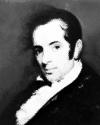- Irving, Washington
-
died Nov. 28, 1859, Tarrytown, N.Y.U.S. author, called the "first American man of letters." He began his career as a lawyer but soon became a leader of the group that published Salmagundi (1807–08), a periodical containing whimsical essays and poems. After his comic A History of New York...by Diedrich Knickerbocker (1809), he wrote little until his very successful The Sketch Book (1819–20), containing his best-known stories, "The Legend of Sleepy Hollow" and "Rip Van Winkle." It was followed by a sequel, Bracebridge Hall (1822). He held diplomatic positions in Madrid, Spain, and writings such as The Alhambra (1832) reflect his interest in Spain's past.
 Washington Irving, oil painting by J.W. Jarvis, 1809; in the Historic Hudson Valley collection.Courtesy of Historic Hudson Valley
Washington Irving, oil painting by J.W. Jarvis, 1809; in the Historic Hudson Valley collection.Courtesy of Historic Hudson Valley* * *
▪ American authorborn April 3, 1783, New York, N.Y., U.S.died Nov. 28, 1859, Tarrytown, N.Y.writer called the “first American man of letters.” He is best known for the short stories “The Legend of Sleepy Hollow” and “Rip Van Winkle.”The favourite and last of 11 children of an austere Presbyterian father and a genial Anglican mother, young, frail Irving grew up in an atmosphere of indulgence. He escaped a college education, which his father required of his older sons, but read intermittently at the law, notably in the office of Josiah Ogden Hoffman, with whose pretty daughter Matilda he early fell in love. He wrote a series of whimsically satirical essays over the signature of Jonathan Oldstyle, Gent., published in Peter Irving's newspaper, the Morning Chronicle, in 1802–03. He made several trips up the Hudson, another into Canada for his health, and took an extended tour of Europe in 1804–06.On his return he passed the bar examination late in 1806 and soon set up as a lawyer. But during 1807–08 his chief occupation was to collaborate with his brother William and James K. Paulding in the writing of a series of 20 periodical essays entitled Salmagundi. Concerned primarily with passing phases of contemporary society, the essays retain significance as an index to the social milieu.His A History of New York . . . by Diedrich Knickerbocker (1809) was a comic history of the Dutch regime in New York, prefaced by a mock-pedantic account of the world from creation onward. Its writing was interrupted in April 1809 by the sudden death of Matilda Hoffman, as grief incapacitated him. In 1811 he moved to Washington, D.C., as a lobbyist for the Irving brothers' hardware-importing firm, but his life seemed aimless for some years. He prepared an American edition of Thomas Campbell's poems, edited the Analectic Magazine, and acquired a staff colonelcy during the War of 1812. In 1815 he went to Liverpool to look after the interests of his brothers' firm. In London he met Sir Walter Scott (Scott, Sir Walter, 1st Baronet), who encouraged him to renewed effort. The result was The Sketch Book of Geoffrey Crayon, Gent (1819–20), a collection of stories and essays that mix satire and whimsicality with fact and fiction. Most of the book's 30-odd pieces concern Irving's impressions of England, but six chapters deal with American subjects. Of these, the tales “The Legend of Sleepy Hollow” and “Rip Van Winkle” have been called the first American short stories. They are both Americanized versions of German folktales. The main character of “Rip Van Winkle” is a henpecked husband who sleeps for 20 years and awakes as an old man to find his wife dead, his daughter happily married, and America now an independent country. The tremendous success of The Sketch Book in both England and the United States assured Irving that he could live by his pen. In 1822 he produced Bracebridge Hall, a sequel to The Sketch Book. He traveled in Germany, Austria, France, Spain, the British Isles, and later in his own country.Early in 1826 he accepted the invitation of Alexander H. Everett to attach himself to the American legation in Spain, where he wrote his Columbus (1828), followed by The Companions of Columbus (1831). Meanwhile, Irving had become absorbed in the legends of the Moorish past and wrote A Chronicle of the Conquest of Granada (1829) and The Alhambra (1832), a Spanish counterpart of The Sketch Book.After a 17-year absence Irving returned to New York in 1832, where he was warmly received. He made a journey west and produced in rapid succession A Tour of the Prairies (1835), Astoria (1836), and The Adventures of Captain Bonneville (1837). Except for four years (1842–46) as minister to Spain, Irving spent the remainder of his life at his home, “Sunnyside,” in Tarrytown, on the Hudson River, where he devoted himself to literary pursuits.Additional Reading* * *
Universalium. 2010.
